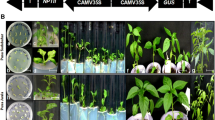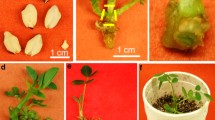Abstract
A method for Agrobacterium tumefaciens-mediated transformation of Pinus radiata cotyledon explants was developed using commercially available open-pollinated seed. Pinus radiata is the most widely planted commercial conifer species in the Southern Hemisphere. Reports on transformation of this species have relied on particle bombardment of embryogenic callus derived from immature embryos. The main drawback to the method is the small number of genotypes that are amenable to transformation and regeneration. Since more than 80% of genotypes of radiata pine can be regenerated using cotyledons from mature seed, cotyledon explants were cocultivated with A. tumefaciens strain AGL1 containing a plasmid coding for the neomycin phosphotransferase II (nptII) gene and the β-glucuronidase (GUS) gene (uidA). Transformed shoots were selected using either geneticin or kanamycin. Critical factors for successful transformation were survival of the cotyledons after cocultivation and selection parameters. Of the 105 putative transformants that were recovered from selection media, 70% were positive for integration of the nptII gene when analysed by PCR. GUS histochemical assay for uidA expression was unreliable because of reaction inhibition by unidentified compounds in the pine needles. Further, only 4 of the 26 independent transformants characterised by PCR and Southern analysis contained an intact copy of both genes. The remaining 22 transformants appeared to have a truncated or rearranged copy of the T-DNA. It is possible that the truncation/rearrangements are due to the Cauliflower mosaic virus (CaMV) 35S promoter. Analysis of the T-DNA junction sites and sequencing of the introduced DNA will help elucidate the nature of T-DNA insertion so that genetic modification of radiata pine can be targeted effectively.






Similar content being viewed by others
References
Aitken-Christie J, Gough K, Maddocks D, Sigley M, Burger F, Carter PCS (1994) Towards commercialisation of conifer embryogenesis. In: Proc 2nd Int Symp Applic Biotechnol Tree Cult Protect Utilization. USDA-For Serv Gen Tech Rep NC-175:181–190
Aitken-Christie J, Singh AP, Davies H (1988) Multiplication of meristematic tissue: A new tissue culture system for radiata pine. In: Hanover JW, Keathley DE (eds) Genetic manipulation of woody plants. Plenum, New York, pp 413–432
Aronen TS (1997) Interactions between Agrobacterium tumefaciens and coniferous defence compounds α-pinene and trans-stilbene. Eur J For Pathol 27:55–67
Birch RG (1997) Plant transformation: problems and strategies for practical application. Annu Rev Plant Physiol Plant Mol Biol 48:297–326
Brukhin V, Clapham D, Elfstrand M, von Arnold S (2000) Basta tolerance as a selectable and screening marker for transgenic plants of Norway spruce. Plant Cell Rep 19:899–903
Campbell MA, Kinlaw CS, Neale DB (1992) Expression of luciferase and β-glucuronidase in Pinus radiata suspension cells using electroporation and particle bombardment. Can J For Sci 22:2014–2018
Charest PA, Devantier Y, Lachance D (1996) Stable genetic transformation of Picea mariana (black spruce) via particle bombardment. In Vitro Cell Dev Biol Plant 32:91–99
Charity JA, Holland L, Donaldson SS, Grace L, Walter C (2002) Agrobacterium-mediated transformation of Pinus radiata organogenic tissue using vacuum-infiltration. Plant Cell Tissus Organ Cult 70:51–60
Dai S, Zheng P, Marmey P, Zhang S, Tian W, Chen S, Beachy RN, Fauquet C (2001) Comparative analysis of transgenic rice plants obtained by Agrobacterium-mediated transformation and particle bombardment. Mol Breed 7:25–33
De Buck S, Jacobs A, Van Montagu M, Depicker A (1999) The DNA sequences of T-DNA junctions suggest that complex T-DNA loci are formed by a recombination process resembling T-DNA integration. Plant J 20:295–304
Deroles S, Gardner RC (1988) Analysis of the T-DNA structure in a large number of transgenic petunias generated by Agrobacterium-mediated transformation. Plant Mol Biol 11:365–377
Doyle J, Doyle J (1990) Isolation of plant DNA from fresh tissue. Focus 12:13–15
Ellis DD, McCabe DE, McInnis S, Ramachandran R, Russell DR, Wallace KM, Martinell BJ, Roberts DR, Raffa KF, McGown BH (1993) Stable transformation of Picea glauca by particle acceleration. Biotechnology 11:84–89
Gelvin SB (2000) Agrobacterium and plant genes involved in T-DNA transfer and integration. Annu Rev Plant Physiol Plant Mol Biol 51:223–256
Gould JH, Zhou Y, Padmanabhan V, Magallanes-Cedeno ME, Newton RJ (2002) Transformation and regeneration of loblolly pine: shoot apex inoculation with Agrobacterium. Mol Breed 10:131–141
Holland L, Gemmell JE, Charity JA, Walter C (1997) Foreign gene transfer into Pinus radiata cotyledons by Agrobacterium tumefaciens. N Z J For Sci 27:289–304
Horgan K, Aitken J (1981) Reliable plantlet formation from embryos and seedling shoot tips of radiata pine. Physiol Plant 53:170–175
Humara JM, Lopez M, Ordas RJ (1999) Agrobacterium tumefaciens-mediated transformation of Pinus pinea L. cotyledons: an assessment of factors influencing the efficiency of uidA gene transfer. Plant Cell Rep 19:51–58
Jefferson RA (1987) Assaying chimeric genes in plants: the GUS gene fusion system. Plant Mol Biol Rep 5:387–405
Klimaszewska K, Devantier Y, Lachance D, Lelu MA, Charest PJ (1997) Larix laricina (tamarack): somatic embryogenesis and genetic transformation. Can J For Res 27:538–550
Kohli A, Leech M, Vain P, Laurie DA, Christou P (1998) Transgene organization in rice engineered through direct DNA transfer supports a two-phase integration mechanism mediated by the establishment of integration hot spots. Proc Natl Acad Sci USA 95:7203–7208
Kohli A, Griffiths S, Palacios N, Twyman RM, Vain P, Laurie DA, Christou P (1999) Molecular characterization of transforming plasmid rearrangements in transgenic rice reveals a recombination hotspot in the CaMV 35S promoter and confirms the predominance of microhomology mediated recombination. Plant J 17:591–601
Kumar S, Fladung M (2000) Transgene repeats in aspen: molecular characterization suggests simultaneous integration of independent T-DNAs into receptive hotspots in the host genome. Mol Gen Genet 264:20–28
Lazo GR, Stein PA, Ludwig RA (1991) A DNA transformation-competent Arabidopsis genomic library in Agrobacterium. Biotechnology 9:963–967
Levée V, Lelu M-A, Jouanin L, Cornu D, Pilate G (1997) Agrobacterium tumefaciens-mediated transformation of hybrid larch (Larix kaempferi x L. decidua) and transgenic plant regeneration. Plant Cell Rep 16:680–685
Levée V, Garin E, Klimaszewska K, Séguin A (1999) Stable genetic transformation of white pine (Pinus strobus L.) after cocultivation of embryogenic tissues with Agrobacterium tumefaciens. Mol Breed 5:429–440
Liew OW (1994) Expression of atrial naturiuretic factor in transgenic potatoes. PhD thesis, Lincoln University, Canterbury
McCullagh P, Nelder JA (1989) Generalised linear models. Chapman and Hall, London
Pawlowski WP, Somers DA (1998) Transgenic DNA integrated into the oat genome is frequently interspersed by host DNA. Proc Natl Acad Sci USA 95:12106–12110
Reed KC, Mann DA (1985) Rapid transfer of DNA from agarose gels to nylon membranes. Nucleic Acids Res 13:7207–7221
Reilly K, Washer J (1977) Vegetative propagation of radiata pine by tissue culture: plantlet formation from embryonic tissue. N Z J For Sci 7:199–206
Smith DR (1986) Forest and nut trees. In: Bajaj YPS (ed) Biotechnology in agriculture and forestry, vol 1. Trees. Springer, Berlin Heidelberg New York, pp 274–289
Smith DR, Walter C, Warr A, Hargreaves CL, Grace LJ (1994) Somatic embryogenesis joins the plantation forestry revolution in New Zealand. In: Proc Tappi Biol Sci Symp. TAPPI, Minneapolis, pp 19–29
Tang W (2003) Additional virulence genes and sonication enhance Agrobacterium tumefaciens-mediated loblolly pine transformation. Plant Cell Rep 21:555–562
Tang W, Sederoff R, Whetton R (2001) Regeneration of transgenic loblolly pine (Pinus taeda L.) from zygotic embryos transformed with Agrobacterium tumefaciens. Planta 213:981–989
Tinland B (1996) The integration of T-DNA into plant genomes. Trends Plant Sci 1:178–184
Vergunst AC, Hooykaas PJJ (1999) Recombination in the plant genome and its application in biotechnology. Crit Rev Plant Sci 18:1–31
Walter C, Grace LJ, Wagner A, White DWR, Walden AR, Donaldson SS, Hinton H, Gardner RC, Smith DR (1998) Stable transformation and regeneration of transgenic plants of Pinus radiata D. Don. Plant Cell Rep 17:460–468
Walter C, Grace LJ, Donaldson J, Moody J, Gemmell JE, van der Maas S, Kvaalen H, Lőnneborg A (1999) An efficient Biolistic transformation protocol for Picea abies embryogenic tissue and regeneration of transgenic plants. Can J For Res 29:1539–1546
Wenck AR, Quinn M, Whetton RW, Pullman G, Sederoff R (1999) High-efficiency Agrobacterium-mediated transformation of Norway spruce (Picea abies) and loblolly pine (Pinus taeda). Plant Mol Biol 39:407–416
Acknowledgements
This research was supported by GEENZ Ltd, Rayonier NZ Ltd, Ernslaw One, Wenita Forest Products, the NZ Foundation for Research, Science and Technology and a Bright Futures Enterprise Scholarship to TMD. We thank Lynn Thomson for technical support, Ruth Butler for statistical analysis, Tracy Williams for helpful suggestions on the manuscript, Dr Dieter Adam and Ms Tania Smith for ongoing encouragement.
Author information
Authors and Affiliations
Corresponding author
Additional information
Communicated by P. Debergh
Rights and permissions
About this article
Cite this article
Grant, J.E., Cooper, P.A. & Dale, T.M. Transgenic Pinus radiata from Agrobacterium tumefaciens–mediated transformation of cotyledons. Plant Cell Rep 22, 894–902 (2004). https://doi.org/10.1007/s00299-004-0769-z
Received:
Revised:
Accepted:
Published:
Issue Date:
DOI: https://doi.org/10.1007/s00299-004-0769-z




